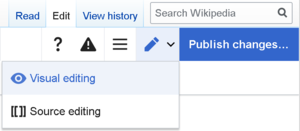Help:VisualEditor/User guide: Difference between revisions
(Send 'em over to MW.org) |
No edit summary |
||
| Line 131: | Line 131: | ||
| The '''switch to source editing''' button is next to the '''{{int|publishchanges}}''' button. It allows you to switch to the wikitext editor. |
| The '''switch to source editing''' button is next to the '''{{int|publishchanges}}''' button. It allows you to switch to the wikitext editor. |
||
|} |
|} |
||
== Publishing changes == |
|||
{| cellpadding="20" |
|||
|- |
|||
| When you are finished editing, press the blue "{{int|publishchanges}}" button in the toolbar. If you have made no changes, the button will be disabled (grayed out). To cancel all your editing changes, close your browser window, or press the "{{int|vector-view-view}}" tab above the edit toolbar. |
|||
| [[File:VisualEditor toolbar actions-en.png|frameless|border|300px|center]] |
|||
|- |
|||
| colspan=2 | <hr /> |
|||
|- |
|||
| Pressing the blue "{{int|publishchanges}}" button opens a dialog. You can then enter a brief summary of your actions, mark your edit as minor, and/or add the page to your {{int|mywatchlist}}. The box for the summary is the equivalent of the {{int|summary}} field in the wikitext editor. |
|||
You can also review your changes using the "{{int|visualeditor-savedialog-label-review}}" button to confirm that they will function as intended before saving your changes. This is similar to the "{{int|showdiff}}" button in the wikitext editor. |
|||
The "{{int|Visualeditor-savedialog-label-resume-editing}}" button returns you to the page you were editing. You can publish all of your changes later. |
|||
| [[File:VisualEditor save dialog-en.png|frameless|border|center|500px]] |
|||
|} |
|||
{{anchor|Editing links}} |
|||
== Editing links == |
|||
{| cellpadding="20" |
|||
|- |
|||
| [[File:VisualEditor - Toolbar - Linking.png|frameless|border|300px|center]] |
|||
| Links can be added through the "{{int|visualeditor-annotationbutton-link-tooltip}}" icon (links in a chain) in the toolbar, or by using the shortcut {{key press|Ctrl|K}} (or {{Key press|Command|K}} on a Mac). |
|||
If you select (highlight) text and then press the "{{int|visualeditor-annotationbutton-link-tooltip}}" button, that text will be used in creating the link. For a link that involves only one word, you can either select that word or just put the cursor within that word. |
|||
|- |
|||
| colspan=2 | <hr /> |
|||
|- |
|||
| [[File:VisualEditor-link tool-search results-en.png|frameless|border|center|400px]] |
|||
| When you use either the button or the shortcut, a dialog will open in which you may type the link. |
|||
The link tool will try to help with '''internal''' links by searching for likely matches. |
|||
|- |
|||
| colspan=2 | <hr /> |
|||
|- |
|||
| [[File:VisualEditor link tool 2015.png|frameless|border|center|400px]] |
|||
| Once you have entered or selected the link, you complete the linking process by pressing {{key press|Enter}} or by pressing the "{{int|visualeditor-dialog-action-done}}" button. Your link will immediately appear on the page, but as with other changes to the page, it will not be published until you publish the ''entire'' page. |
|||
|- |
|||
| colspan=2 | <hr /> |
|||
|- |
|||
| [[File:VisualEditor-link tool-external link.png|frameless|border|400px|center]] |
|||
| To link to a web page on another website, the process is similar: Choose the "{{int|visualeditor-linkinspector-button-link-external}}" tab, and enter a URL in the box. |
|||
|- |
|||
| colspan=2 | <hr /> |
|||
|- |
|||
| [[File:VisualEditor link tool simple link.png|frameless|border|400px|center]] |
|||
| External links without labels look like this: [http://example.com]. You can add these by placing your cursor away from any word (e.g., after a space). Open the link tool by pressing on the button or pressing the shortcut keys. Type the URL in the box, and press the "{{int|visualeditor-dialog-action-done}}" button to insert the link. |
|||
|- |
|||
| colspan=2 | <hr /> |
|||
|- |
|||
| [[File:VisualEditor-context menu-link tool.png|frameless|border|400px|center]] |
|||
| To change or remove an existing link, press within the text for that link, then press the "{{int|visualeditor-annotationbutton-link-tooltip}}" icon that appears near it. The dialog will appear, for editing. You can also get to the dialog with the {{key press|Ctrl|K}} keyboard shortcut. When a link is selected, it appears as blue framed. |
|||
In the link editing dialog, you can then change where the link goes. You can also remove the link entirely by pressing the "{{int|visualeditor-inspector-remove-tooltip}}" button in the upper right corner of the dialog. You can also open the link's target in another window by pressing on the copy of the link in the dialog box. (You might want do this to check if an external link is valid.) |
|||
If you want to exit the link label (the text displayed as a link) or continue to write after this link, you can press {{Key press|→}}: |
|||
*Pressing it once will escape the link editing dialog and put your cursor at the end of the element linked (blue framed, to edit this element) |
|||
*Pressing it twice will put the cursor after the element linked, ready to type the rest of your text. |
|||
To edit the link label of an existing link, press within the link label and type the new one. But if you want to replace the entire label, please note: |
|||
* If you have selected (highlighted) the entire link label, the link will be deleted by typing any key. You may link it from start. |
|||
* To keep the link directly, you may press within that link label, use backspace and delete key without pressing it once more than necessary, and a narrow blue link area will remain there. Now you may type in the new label for the kept link. |
|||
* You can also [[mw:Help:VisualEditor/User guide/Links|link to categories, files and more]]. |
|||
|} |
|||
{{anchor|EditingReferences}} |
|||
Revision as of 17:17, 25 August 2019
Opening the visual editor
Getting started: the visual editor's toolbar
| The visual editor's toolbar appears at the top of the screen when you begin editing. It includes some familiar icons: | |
| Undo and Redo the changes you have made. | |
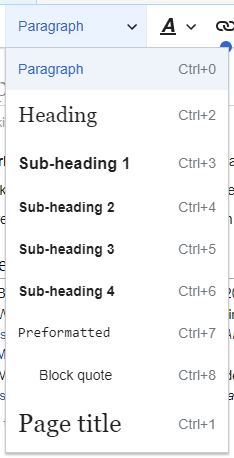 |
Headings pull-down menu: allows you to change how the paragraph is formatted. To change the style of a paragraph, put your cursor in the paragraph and select an item in this menu (you don't have to highlight any text). Section titles are formatted "Heading", and subsections are "Sub-heading 1", "Sub-heading 2", and so on. The normal format for text is "Paragraph". |
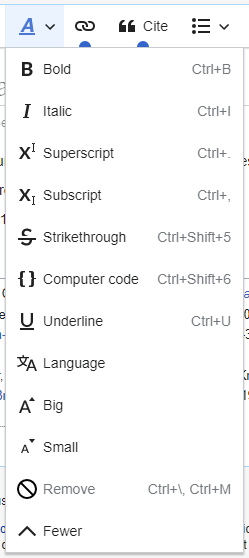 |
Formatting: Pressing the "A" opens a menu.
If you have not selected any text, then when you press the "A" to open the menu, and then select an item, that formatting will apply to the text that you start typing, from wherever your cursor is located. |
 |
Linking tool: The chain icon is the linking tool. Pressing on it (usually after selecting some text) opens the link dialog. |
 |
Cite menu: The "Cite" menu is used to add inline citations (also called "footnotes" or "references"). All projects have access to basic reference formatting and the ability to reuse citations by using this menu. It also gives users quick access to local citation templates, if these are enabled on their wiki.
(Instructions for adding local citation templates to the Cite menu at a specific wiki are available at mw:VisualEditor/Citation tool.) |
 |
⧼citoid-citefromidtool-title⧽ button: If the citoid service is enabled on your wiki, then you will see a ⧼citoid-citefromidtool-title⧽ button instead of a Cite menu.
The citoid service tries to fill out citation templates automatically. |
 |
Lists and indentation: The first two items allow you to format text as either a "Bullet list" or a "Numbered list". The last two items allow you to decrease or increase the indentation level of list items. |
 |
Insert: The "Insert" menu may be different on some projects. Below is a list of all options that may appear.
|
| Special character insertion: The "Special character" (Ω) icon is next to the "Insert" menu. When pressed, it displays a dialog showing many special characters. By pressing on a specific character, you place it into the text. These special characters include some standard symbols, diacritics, and mathematical symbols. (This list may be customized locally. See mw:VisualEditor/Special characters for instructions.) | |
| The Edit notices button displays any notices for the page. | |
 |
The Page options menu is to the left of the Publish changes button and the Switch editor menu. On this menu there is a button to open an Options dialog with the following (left side) tabs:
The tabs of the Options dialog are also displayed in the Page options menu and can be opened by clicking on it. Furthermore the Page options menu contains the button View as right-to-left and the button Find and replace which opens a dialog where you can insert characters, terms or Regular expressions you are searching for and those to replace them with, together with several buttons for options. |
| The switch to source editing button is next to the Publish changes button. It allows you to switch to the wikitext editor. | |
Publishing changes
| When you are finished editing, press the blue "Publish changes" button in the toolbar. If you have made no changes, the button will be disabled (grayed out). To cancel all your editing changes, close your browser window, or press the "Read" tab above the edit toolbar. | |
| Pressing the blue "Publish changes" button opens a dialog. You can then enter a brief summary of your actions, mark your edit as minor, and/or add the page to your Watchlist. The box for the summary is the equivalent of the Edit summary (Briefly describe your changes) field in the wikitext editor.
You can also review your changes using the "Review your changes" button to confirm that they will function as intended before saving your changes. This is similar to the "Show changes" button in the wikitext editor. The "Resume editing" button returns you to the page you were editing. You can publish all of your changes later. |
 |
Editing links
 |
Links can be added through the "Link" icon (links in a chain) in the toolbar, or by using the shortcut ^ Ctrl+K (or ⌘ Command+K on a Mac).
If you select (highlight) text and then press the "Link" button, that text will be used in creating the link. For a link that involves only one word, you can either select that word or just put the cursor within that word. |
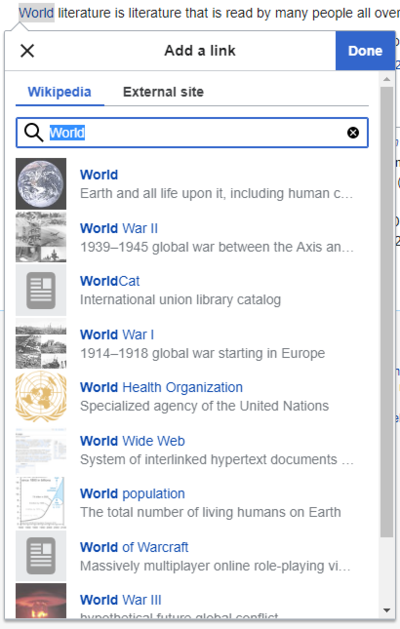 |
When you use either the button or the shortcut, a dialog will open in which you may type the link.
The link tool will try to help with internal links by searching for likely matches. |
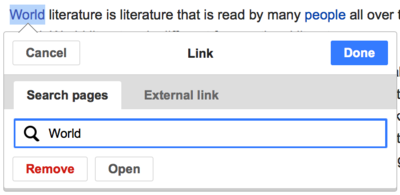 |
Once you have entered or selected the link, you complete the linking process by pressing ⌅ Enter or by pressing the "Done" button. Your link will immediately appear on the page, but as with other changes to the page, it will not be published until you publish the entire page. |
 |
To link to a web page on another website, the process is similar: Choose the "External site" tab, and enter a URL in the box. |
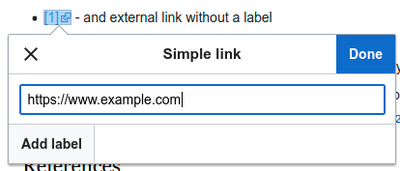 |
External links without labels look like this: [1]. You can add these by placing your cursor away from any word (e.g., after a space). Open the link tool by pressing on the button or pressing the shortcut keys. Type the URL in the box, and press the "Done" button to insert the link. |
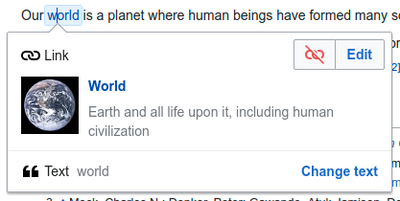 |
To change or remove an existing link, press within the text for that link, then press the "Link" icon that appears near it. The dialog will appear, for editing. You can also get to the dialog with the ^ Ctrl+K keyboard shortcut. When a link is selected, it appears as blue framed.
In the link editing dialog, you can then change where the link goes. You can also remove the link entirely by pressing the "Remove" button in the upper right corner of the dialog. You can also open the link's target in another window by pressing on the copy of the link in the dialog box. (You might want do this to check if an external link is valid.) If you want to exit the link label (the text displayed as a link) or continue to write after this link, you can press →:
To edit the link label of an existing link, press within the link label and type the new one. But if you want to replace the entire label, please note:
|
